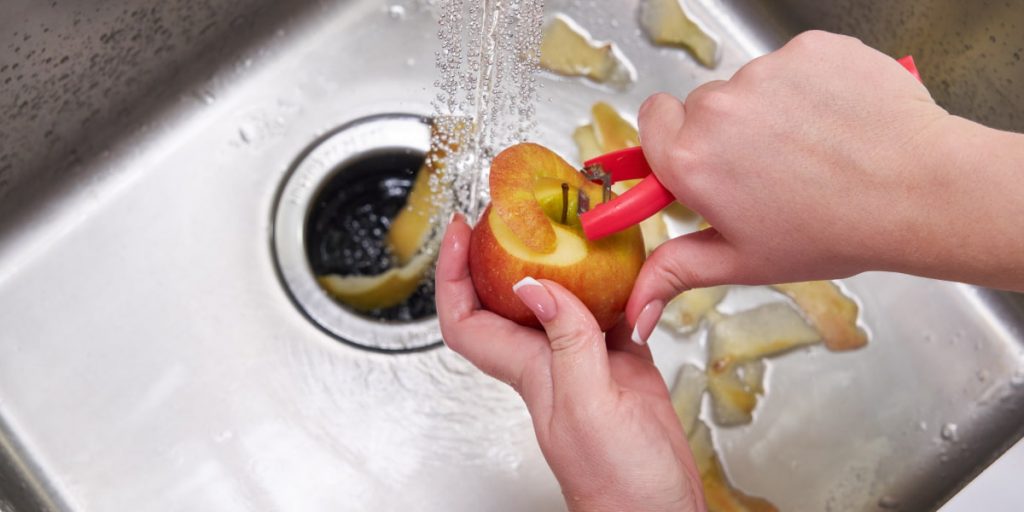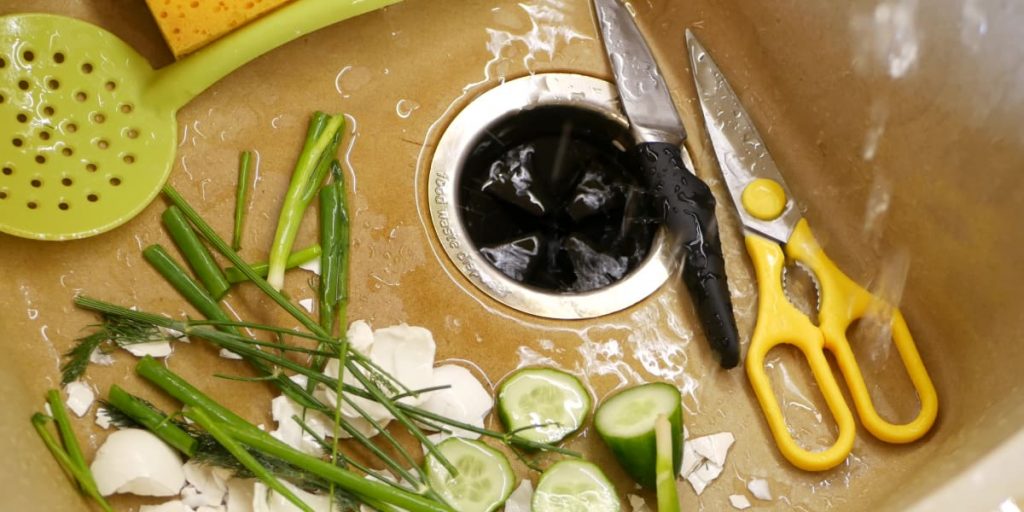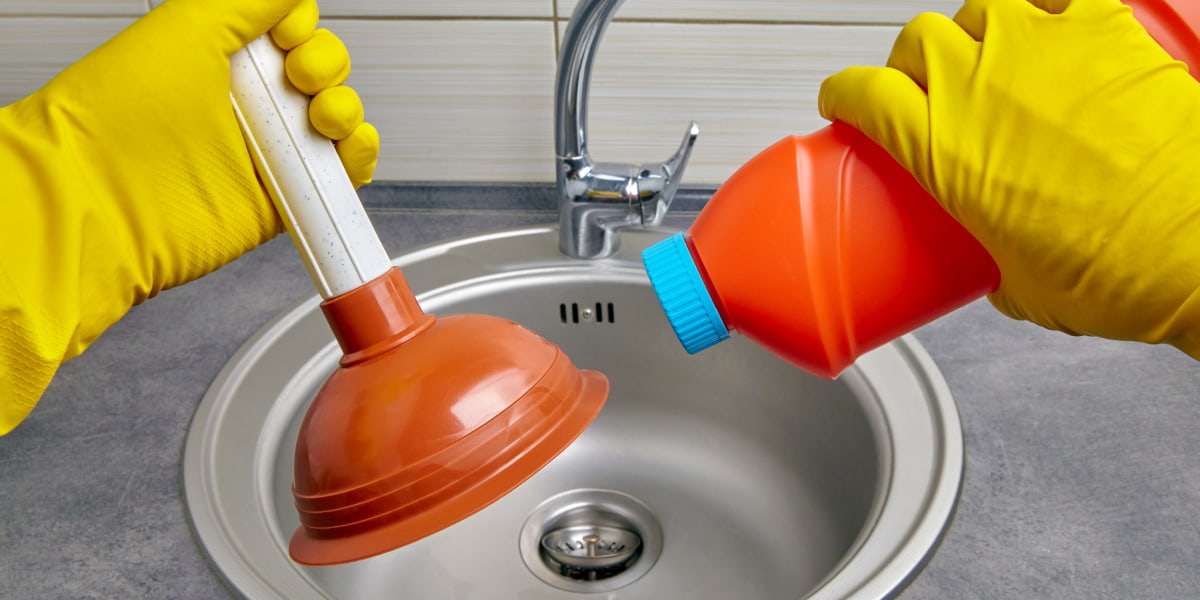Published on October 31st, 2022
Last updated on February 3rd, 2023
How To Fix The Garbage Disposal On Your Own?

Working in the kitchen goes smoothly and efficiently when you have the right tools to speed up your cooking and recycling. So, for example, you can find in many modern kitchens convenient garbage disposals that do an excellent job with organic waste, so people don’t need to throw it into the trash. Electric garbage disposal has many advantages, but even such a convenient device can wear out and become unusable over time.
Unfortunately, repairing such a device is not always easy enough, and the cause of the breakdown is not always obvious. So, we will tell you how to understand that your garbage disposal is broken and what to do if it hums, seizes, stalls, or becomes clogged with debris. However, you will need to free up at least two hours for the procedure.
Repairing Garbage Disposal

So, before repairing, you must find out what caused the problems in the device. The reasons could be a wiring problem, an incorrectly set safety switch, a broken engine, a malfunction in the blades inside the garbage disposal, or even a fluid leak. In the following blocks, we will look at each of these cases and provide detailed instructions on fixing all of these components.
However, always remember safety precautions when working with devices such as a shredder or electric garbage disposals. You should disconnect such devices from the network before the repairing procedure. Also, never dip your fingers into the chopper, even if you’re sure it’s out of power completely.
It is best to use special tools to keep your hands always protected.
Garbage Disposal Not Turning On
You turn on the utilizer in the network, but it doesn’t show signs of life? Don’t you hear the sound of the motor, and the blades do not rotate? In this case, a breakdown may be caused due to a problem with the current supply to the mechanism. In this case, gradually solving the problem from simple to complex is necessary. Your actions will look like this:
- Before you panic and rush to fix a garbage disposal, ensure your device has a connection to the network.
- Click on the reset button. This red button is usually located at the bottom of the device.
- You should check the main service panel if the reset button does not help. You need to make sure that the circuit breaker does not work. If the problem is in it, reinstall the lever.
- If the solution does not help, you should check your wiring with the switch that controls the device to turn on.
- You need to turn off the circuit breaker. Then dismantle the switch that controls disposal. Check the wires for the integrity and reliability of the wires. If everything is in order with the cables, the problem may be in the switch itself. Replace it.
- If your garbage disposal does not work even after that, you should replace it with a new one, as yours is beyond repair.
Grinding Doesn’t Work
If you hear the sound of the engine when turning on the garbage disposal, but the blades and the chopper stopped working, the flywheel is jammed.
This is due to foreign debris getting stuck between the impeller and the chopper ring. To fix it, follow these steps:
- Turn off the garbage disposal power completely. Also, turn off the switch that controls recycling.
- Find the bent wrench with the device or buy a new one from a garbage disposal store. Insert the tool into the flywheel turning hole at the unit’s bottom.
- Then turn the tool clockwise. You will notice that the flywheel moves freely.
- After that, shine a flashlight from your phone or another light source to find the object that caused the problem. Use tongs or pliers to remove the stuck object.
- Turn on the power on the main service panel, but do not turn on the disposal.
- Press the reset button.
- Pour water into the disposer and quickly turn the switch on and off. If everything works, you can not worry and use your device again.
Fixing a Leak
A garbage disposal that leaks from the bottom is usually easy to fix. In most cases, the leak is due to a loose connection. Follow the steps below to repair a leaking garbage disposal:
- First, identify the source of the leak. Is the leak coming from where the disposal meets the sink flange? If so, then the problem is most likely a loose connection. Use a wrench to tighten the bolts that secure the disposal to the sink flange.
- If the leak is not coming from where the disposal meets the sink flange, then it is probably coming from a cracked or damaged disposer housing. To replace the disposer housing, follow these steps:
- Turn off the power to the garbage disposal at your home’s breaker box.
- Remove the dishwasher hose, if applicable.
- Use an Allen wrench to remove the mounting ring by turning it counterclockwise until it comes loose.
- Pull the disposer away from the sink flange and dispose of it properly.
- Insert the new disposer into place and hand-tighten the mounting ring clockwise until it is snug against disposer housing—do not overtighten!
- Reconnect dishwasher hose, if applicable, and turn on power to garbage disposal at your home’s breaker box. Test for leaks by running water into the disposer and check for any leaks around the mounting ring or disposer housing.
- If there are no leaks, then you have successfully fixed your leaking garbage disposal!
Fixing a Slow Drain
Most often, this garbage disposal problem has a connection to the fact that excess debris inside the pipes could accumulate or get stuck. Most often, solving this problem is quite simple; you need to:
- Remove the bolts that hold the discharge pipe.
- Disconnect the drain trap and remove it and the drain pipe.
- Remove any debris that may have accumulated there.
- Put everything back together and rinse with water.
Keep in mind that you shouldn’t use chemicals to clean pipes and sinks when they connect to garbage disposal as this is dangerous to your health and damages components necessary for the operation of the garbage chute, which voids the manufacturer’s warranty.
To avoid such problems, follow the rules of what you can throw into the garbage chute and what you should put in the bin.
How Does Garbage Disposal Work?

Garbage disposal, also known as a waste disposal unit or food waste disposer, is a device that helps shred food waste into smaller pieces so that it can be easily rinsed down the drain. Many people think garbage disposals are complex and dangerous, but they are quite simple devices.
Typical garbage disposal consists of three main parts: a flywheel, an impeller, and a grinding chamber. The flywheel is a disc that is attached to the motor. As the motor turns, the flywheel also turns. The impeller is a series of blades that stick to the flywheel. As the flywheel turns, the impeller blades spin and chop up the food waste. The grinding chamber is where the food waste is shredded. It is usually made of stainless steel and has small holes that allow water to flow through while trapping the food particles.
When you turn on your garbage disposal, the motor starts spinning the flywheel. This causes the impeller blades to spin as well. As the impeller blades spin, they chop the food waste into small pieces. The small pieces of food then fall through the holes in the grinding chamber and are flushed down the drain with water.
What Can’t You Put Into Garbage Disposal?

There are some things that you should never put down on your garbage disposal if you want it not to stop working. These items can damage the blades, clog the plumbing, and cause other problems:
- First, you should avoid any type of hard food waste. This includes bones, fruit seeds, nutshells, and more. These items can easily damage the blades of your disposal, and they may also get caught in the plumbing and cause clogs.
- Second, you should avoid putting stringy or fibrous foods down the drain. This includes celery, eggshells, corn husks, and more. These items can tangle around the blades and cause serious damage.
- Finally, you should never put oil or grease down the drain. These liquids can solidify in cold pipes and cause difficulty in removing clogs.
Following these tips can help keep your garbage disposal in good working condition for years to come.
How to Prevent Garbage Disposal Breakdown?

Garbage disposal is a handy appliance to have in the kitchen. It helps keep the sink clean and free of food waste. However, like all appliances, garbage disposal can break down and need repairing. In this block, we will give you tips on preventing garbage disposal breakdown.
Here are some tips on how to prevent garbage disposal breakdown:
- Do not put hard objects into the disposal.
- Do not put stringy or fibrous objects into the disposal.
- Do run cold water when using the disposal.
- Do use a moderate amount of force when grinding food waste.
- Do not overfill the disposal chamber.
- Do clean the disposer regularly with ice and rock salt.
- Call a professional if you think something is wrong with the disposer.
By following these tips, you can help prevent garbage disposal breakdown. If you experience a garbage disposal problem, be sure to call a professional for help.
Conclusion
As you can see, even without special knowledge and preparation, you can easily fix the garbage disposal that is not turning on and enjoy a convenient kitchen device again. However, consider the safety precautions and do not put your fingers inside the disposer, as you may harm yourself.
Also, follow preventive measures to keep your kitchen waste chute clean and get only efficient performance from the device.
FAQ
Why is my garbage disposal not working?
Turn the power on. If the disposal does not work, there may be a problem with the motor or blade. If you cannot turn the flywheel or it spins freely, the engine may be defective. If the blade is not working, it may be dull or frozen and need to be replaced.
How much does it cost to repair garbage disposal?
You can attempt to unclog the device on your own, but if you cannot do so, you must hire a plumber to clear a clog from deeper into the pipes. While it may cost $150 to $200, replacing the unit would be significantly more expensive.
My garbage disposal is working, but it’s making noise. What’s wrong?
Turn off the power to the disposal and use a flashlight to look for anything that may be stuck. If you see something stuck, try to remove it with a pair of tongs. If you cannot remove it, the blades may need to be replaced. Another possible cause of the noise is a loose mounting screw. Tighten any screws that are loose.
Is garbage disposal worth buying?
Any plumber would strongly advise installing a garbage disposal unit in your home because it is an efficient way to deal with everyday kitchen waste, like uneaten food, by shredding it into small pieces. They can, therefore, easily go through plumbing.


